
Want to create or adapt books like this? Learn more about how Pressbooks supports open publishing practices.
Capstone Components

12 Research Design
The story continues….
“So, how do we go about answering our research questions?” asked Harry.
Physicus explained that they will have to analyze their questions to see what types of answers are required. Knowing this will guide their decisions about how to design the needs assessment to answer their questions.
“There are two basic types of answers to research questions, quantitative and qualitative. The types of answers the questions require tell us what type of research design we need,” said Physicus.
“I guess if I ask how we decide which type of research design we should choose, you will say, ‘It depends?'” uttered Harry.
Physicus’ face brightened as he blurted out, “Absolutely not! Negative!” Physicus continued, “If the research questions are stated well, there will only be two ways in which they can be answered. The research questions are king; they make all the decisions.”
“How come?” Harry appeared confused.
“Well, let us see. Think about our first question. How many mice will Pickles attack at one time? What type of answer does this question require? It requires a numeric answer, correct?” Physicus asked.
“Yes, that is correct,” Harry said.
Physicus continued, “Good. So, does our second question also require a numeric answer?”
“The second question is also answered with a number,” replied Harry
Physicus blurted, “Correct! This means we need to use a quantitative research design!”
Physicus continued, “Now if we had research questions that could not be answered with numbers, we would need to use a qualitative research design to answer our questions with words or phrases instead.”
Harry now appeared relieved, “I get it. So in designing a research project, we simply look for a way to answer the research questions. That’s easy!”
“Well, it depends,” answered Physicus smiling.
Interpreting the Story
There are qualitative, quantitative, mixed methods, and applied research designs. Based on the research questions, the research design will be obvious. Physicus led Harry in determining their investigation would need a quantitative design, because they only needed numerical data to answer their research questions. If Harry’s questions could only be answered with words or phrases, then a qualitative design would be needed. If the friends had questions needing to be answered with numbers and phrases, then either a mixed methods or an applied research design would have been the choice.
Research Design
The Research Design explains what type of research is being conducted in the needs assessment. The writing in this heading also explains why this type of research is needed to obtain the answers to the research or guiding questions for the project. The design provides a blueprint for the methodology. Articulating the nature of the research design is critical for explaining the Methodology (see the next chapter).
There are four categories of research designs used in educational research and a variety of specific research designs in each category. The first step in determining which category to use is to identify what type of data will answer the research questions. As in our story, Harry and Physicus had research questions that required quantitative answers, so the category of their research design is quantitative.
The next step in finding the specific research design is to consider the purpose (goal) of the research project. The research design must support the purpose. In our story, Harry and Physicus need a quantitative research design that supports their goal of determining the effect of the number of mice Pickles encounters at one time on his behavior. A causal-comparative or quasi-experimental research design is the best choice for the friends because these are specific quantitative designs used to find a cause-and-effect relationship.
Quantitative Research Designs
Quantitative research designs seek results based on statistical analyses of the collected numerical data. The primary quantitative designs used in educational research include descriptive, correlational, causal-comparative, and quasi-experimental designs. Numerical data are collected and analyzed using statistical calculations appropriate for the design. For example, analyses like mean, median, mode, range, etc. are used to describe or explain a phenomenon observed in a descriptive research design. A correlational research design uses statistics, such as correlation coefficient or regression analyses to explain how two phenomena are related. Causal-comparative and quasi-experimental designs use analyses needed to establish causal relationships, such as pre-post testing, or behavior change (like in our story).
The use of numerical data guides both the methodology and the analysis protocols. The design also guides and limits how the results are interpreted. Examples of quantitative data found in educational research include test scores, grade point averages, and dropout rates.
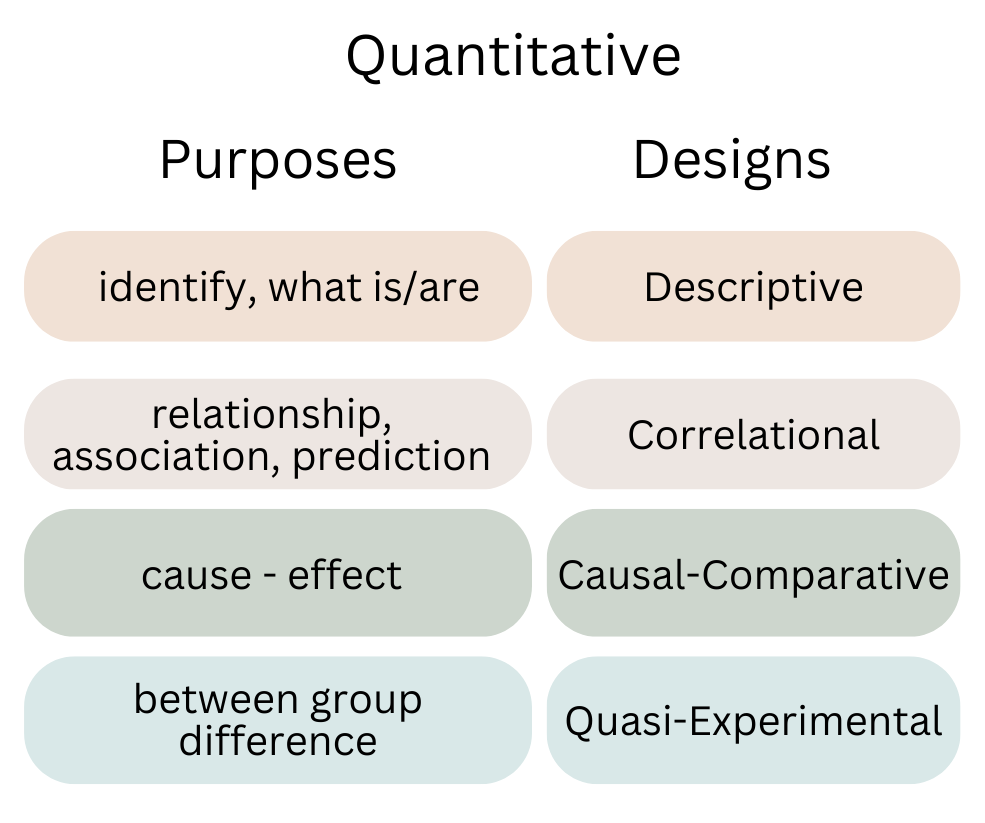
Qualitative Research Designs
Qualitative research designs involve obtaining verbal, perspective, and/or visual results using code-based analyses of collected data. Typical qualitative designs used in educational research include the case study, phenomenological, grounded theory, and ethnography. These designs involve exploring behaviors, perceptions/feelings, and social/cultural phenomena found in educational settings.
Qualitative designs result in a written description of the findings. Data collection strategies include observations, interviews, focus groups, surveys, and documentation reviews. The data are recorded as words, phrases, sentences, and paragraphs. Data are then grouped together to form themes. The process of grouping data to form themes is called coding. The labeled themes become the “code” used to interpret the data. The coding can be determined ahead of time before data are collected, or the coding emerges from the collected data. Data collection strategies often include media such as video and audio recordings. These recordings are transcribed into words to allow for the coding analysis.
The use of qualitative data guides both the methodology and the analysis protocols. The “squishy” nature of qualitative data (words vs. numbers) and the data coding analysis limits the interpretation and conclusions made from the results. It is important to explain the coding analysis used to provide clear reasoning for the themes and how these relate to the research questions.
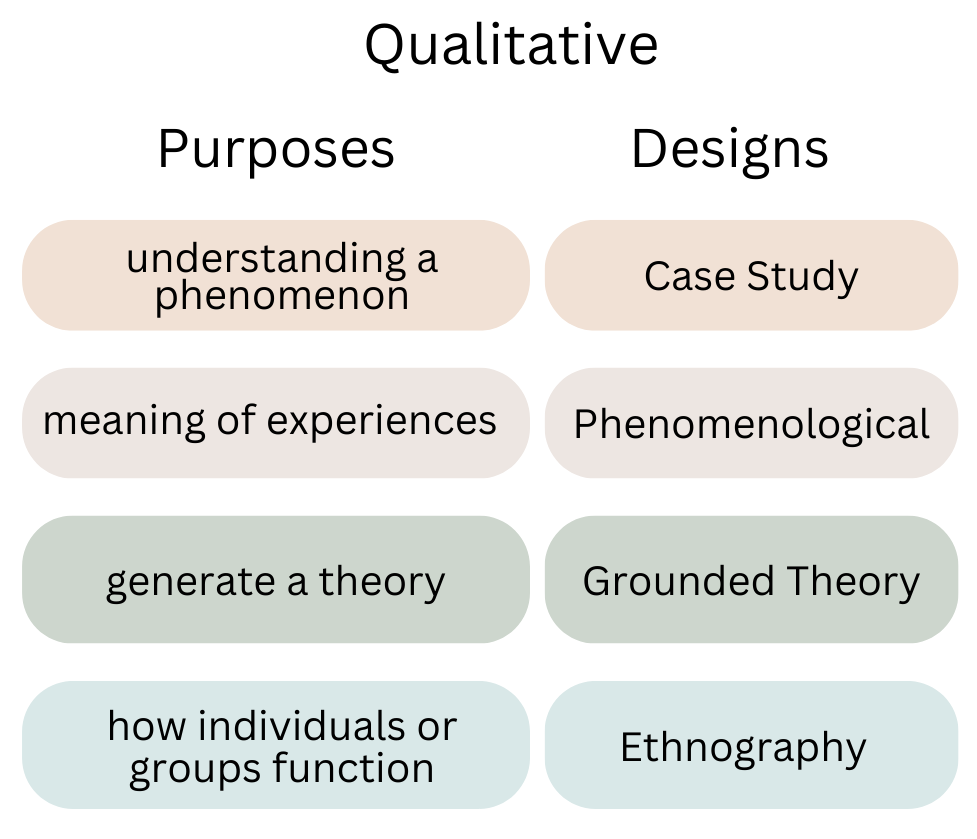
Mixed Method Designs
Mixed Methods research designs are used when the research questions must be answered with results that are both quantitative and qualitative. These designs integrate the data results to arrive at conclusions. A mixed method design is used when there are greater benefits to using multiple data types, sources, and analyses. Examples of typical mixed methods design approaches in education include convergent, explanatory, exploratory, and embedded designs. Using mixed methods approaches in educational research allows the researcher to triangulate, complement, or expand understanding using multiple types of data.
The use of mixed methods data guides the methodology, analysis, and interpretation of the results. Using both qualitative (quant) and quantitative (qual) data analyses provides a clearer or more balanced picture of the results. Data are analyzed sequentially or concurrently depending on the design. While the quantitative and qualitative data are analyzed independently, the results are interpreted integratively. The findings are a synthesis of the quantitative and qualitative analyses.
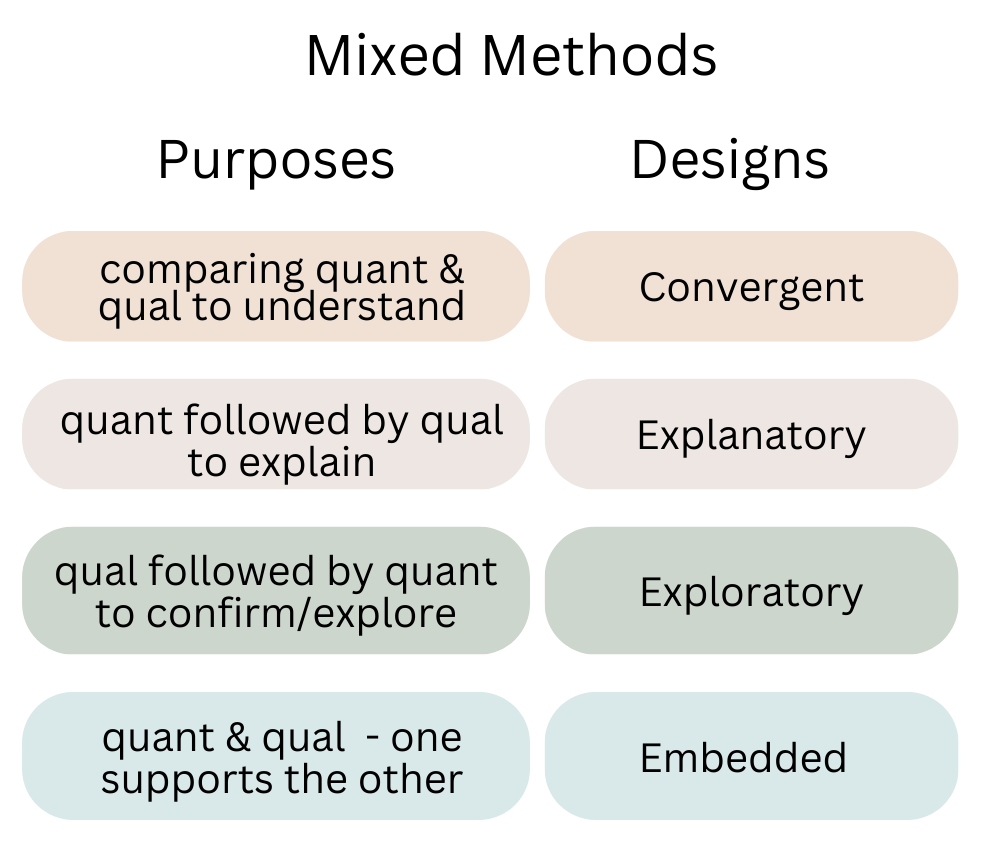
Applied Research Designs
Applied research designs seek both quantitative and qualitative results to address issues of educational practice. Applied research designs include evaluation, design and development, and action research. The purposes of applied research are to identify best practices, to innovate or improve current practices or policies, to test pedagogy, and to evaluate effectiveness. The results of applied research designs provide practical solutions to problems in educational practice.
Applied designs use both theoretical and empirical data. Theoretical data are collected from published theories or other research. Empirical data are obtained by conducting a needs assessment or other data collection methods. Data analyses include both quantitative and qualitative procedures. The findings are interpreted integratively as in mixed methods approaches, and then “applied” to the problem to form a solution.
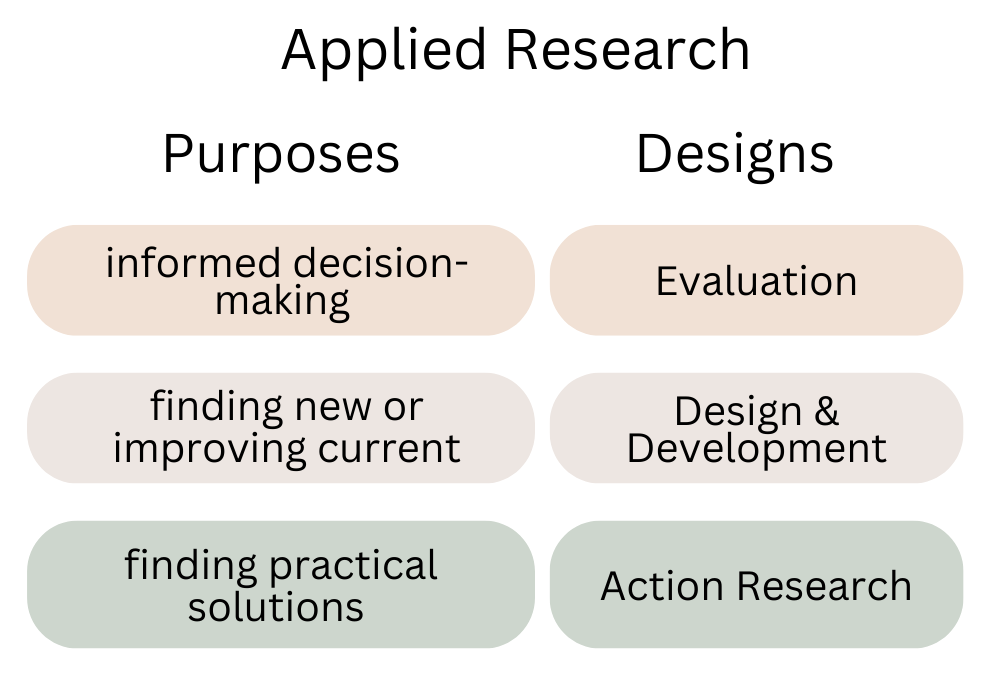
Telling the research story
The Research Design in a research project tells the story of what direction the plot of the story will take. The writing in this heading sets the stage for the rising action of the plot in the research story. The Research Design describes the journey that is about to take place. It functions to guide the reader in understanding the type of path the story will follow. The Research Design is the overall direction of the research story and is determined before deciding on the specific steps to take in obtaining and analyzing the data.
The Research Design heading appears in Chapter 2 of a capstone project. In the capstone project, the Research Design explains the type of design used for conducting the needs assessment.
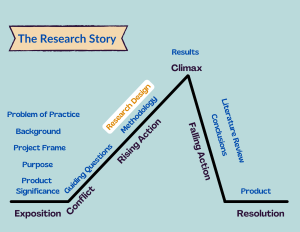
Capstone Projects in Education: Learning the Research Story Copyright © 2023 by Kimberly Chappell and Greg I. Voykhansky is licensed under a Creative Commons Attribution-NonCommercial-ShareAlike 4.0 International License , except where otherwise noted.
- Thesis Action Plan New
- Academic Project Planner
Literature Navigator
Thesis dialogue blueprint, writing wizard's template, research proposal compass.
- Why students love us
- Rebels Blog
- Why we are different
- All Products
- Coming Soon
How to Do a Capstone Project: A Step-by-Step Approach

Starting your capstone project is a major milestone in your academic journey. This guide breaks down the process into clear, actionable steps, ensuring you have the confidence and tools to succeed at every stage.
From selecting a suitable topic to presenting and defending your project, this article covers everything you need to know to make your capstone project a rewarding experience.
Key Takeaways
- Understand the multifaceted nature and purpose of a capstone project within an academic curriculum and its real-world applications.
- Choose a topic that aligns with your interests, is feasible to research, and supports your career goals.
- Conduct a thorough literature review to gather relevant sources, analyze existing research, and identify gaps that your project can address.
- Design a robust research methodology, considering ethical aspects and appropriate data collection techniques.
- Effectively present and defend your capstone project by structuring your final report, preparing for the defense, and responding to feedback.
Understanding the Purpose of a Capstone Project
A capstone project is a culmination of your academic journey , designed to assess the cumulative knowledge and skills you have gained. It is an integral part of academics , often requiring an interdisciplinary approach to solve a problem or contribute to your field. This project not only tests your competencies but also prepares you for real-world challenges, making you a well-rounded graduate ready for the workforce.
Selecting a Suitable Topic
Selecting the perfect topic for your capstone project is a critical step toward academic success and aligning with your future career goals. Your chosen topic should align with your academic objectives and future career aspirations. The nature of an appropriate project topic is that it will contribute to academic growth while preparing you for challenges in the respective field.
Conducting a Comprehensive Literature Review
Conducting a thorough literature review is essential to building a strong foundation for your capstone project. It involves a systematic examination of existing research to build a foundation for your study. Invest time in writing a compelling literature review as it is supposed to pinpoint gaps or unanswered questions and hypotheses.
Designing the Research Methodology
When designing your research methodology, it is crucial to choose methods that align with your research question and objectives. Selecting the appropriate methods ensures that your data collection and analysis will be effective and relevant to your study. Consider the ethical implications of your chosen methods, ensuring that your research adheres to ethical standards and guidelines. Data collection techniques should be meticulously planned to gather accurate and comprehensive data. This involves deciding on the tools and procedures that will best capture the information you need.
Executing the Project Plan
Time management strategies.
Effective time management is crucial for the successful execution of your capstone project. Create a schedule that outlines all the tasks you need to complete, along with their deadlines. This will help you stay organized and ensure that you allocate sufficient time for each phase of the project. Utilize tools like Gantt charts or project management software to keep track of your progress and make adjustments as needed.
Collaborative Work
Collaboration can significantly enhance the quality of your capstone project. Engage with your peers, advisors, and other stakeholders to gather diverse perspectives and insights. Establish clear communication channels and set regular meetings to discuss progress and address any issues that arise. Remember, effective collaboration requires mutual respect and a willingness to compromise.
Monitoring Progress
Regularly monitoring your progress is essential to ensure that you stay on track. Set specific milestones and key performance indicators (KPIs) to measure your achievements. This will help you identify any deviations from your plan early on and take corrective actions. Additionally, keep a detailed record of your activities and outcomes to facilitate the final reporting and evaluation process.
Presenting and Defending Your Capstone Project
Presenting and defending your capstone project is a critical phase that showcases your hard work and understanding of the subject. Structuring the final report is essential to ensure clarity and coherence. Your report should include a title page, abstract, table of contents, introduction, methodology, results, discussion, conclusion, and references. Each section must be meticulously crafted to reflect your research journey and findings.
Preparing for the defense involves anticipating questions and practicing your presentation multiple times. You should be able to explain your project's objectives, methodology, and outcomes confidently. Additionally, consider presenting at student conferences to share vital data and evidence, which can help you gain feedback and improve your defense.
Responding to feedback is a crucial skill during your defense. Listen carefully to the questions and comments from your panel, and respond thoughtfully. This not only demonstrates your deep understanding of the project but also your ability to engage in academic discourse. Remember, the defense is not just about defending your work but also about showcasing your ability to think critically and adapt to new insights.
Reflecting on the Capstone Experience
Assessing personal growth.
Reflect on your college journey, apply lessons from thesis, prepare for future endeavors. Personal growth, self-awareness, and professional success emphasized.
Lessons Learned
Reflecting on your capstone project allows you to identify the key lessons learned throughout the process. This reflection can help you understand what strategies worked well and what could be improved in future projects. Embrace these insights as they are invaluable for your academic and professional development.
Future Implications
Consider the future implications of your capstone project. How can the skills and knowledge you gained be applied in your career? Reflect on how this experience has prepared you for future challenges and opportunities. This reflection will help you to better navigate your professional path and achieve long-term success.
Reflecting on the Capstone Experience, it's clear that the journey is filled with challenges and triumphs. If you're a student feeling overwhelmed by your thesis, our step-by-step Thesis Action Plan is here to help. With proven methodologies and strategies, we guide you through every step, ensuring you overcome obstacles and achieve success. Don't let anxiety hold you back—visit our website to claim your special offer now and start your journey to a stress-free thesis experience.
In conclusion, undertaking a capstone project is a significant academic endeavor that requires meticulous planning, dedication, and a systematic approach. By following the step-by-step guidelines outlined in this article, students can navigate the complexities of their capstone projects with greater confidence and clarity. From selecting a compelling topic to conducting thorough research and presenting a well-structured final report, each phase of the process is crucial for achieving academic success. Remember, the journey of completing a capstone project not only enhances your research and analytical skills but also prepares you for future professional challenges. Embrace the process, seek guidance when needed, and strive for excellence in every step of your capstone project.
Frequently Asked Questions
What is a capstone project.
A capstone project is a multifaceted assignment that serves as a culminating academic and intellectual experience for students. It involves in-depth research, analysis, and the application of knowledge gained during your academic tenure.
How do I choose a suitable topic for my capstone project?
Choosing a suitable topic involves identifying areas of interest, evaluating the feasibility of the topic, and ensuring it aligns with your career goals. It's important to select a topic that is both engaging and manageable within the given timeframe.
What are the key components of a comprehensive literature review?
A comprehensive literature review involves gathering relevant sources, analyzing existing research, and identifying research gaps. This helps in understanding the current state of knowledge on your topic and shaping your research questions.
What research methods are appropriate for a capstone project?
The choice of research methods depends on your project goals and the nature of your research questions. Common methods include qualitative, quantitative, or mixed-method approaches. It's crucial to choose methods that are ethical and suitable for your data collection needs.
How can I effectively manage my time during the capstone project?
Effective time management strategies include creating a detailed project plan, setting realistic deadlines, prioritizing tasks, and regularly monitoring progress. Tools like project management software can also help in keeping track of milestones and deadlines.
What should I expect during the presentation and defense of my capstone project?
During the presentation and defense, you will need to structure your final report clearly, prepare to discuss your research findings, and respond to feedback from your committee or audience. Practice and preparation are key to a successful defense.

Discovering Statistics Using IBM SPSS Statistics: A Fun and Informative Guide

Unlocking the Power of Data: A Review of 'Essentials of Modern Business Statistics with Microsoft Excel'

Discovering Statistics Using SAS: A Comprehensive Review
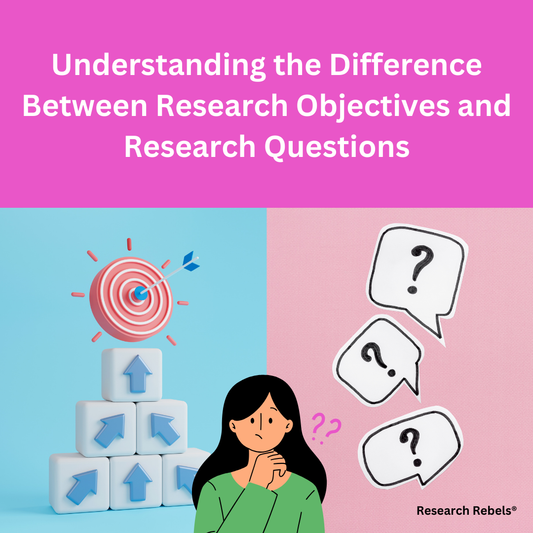
Understanding the Difference Between Research Objectives and Research Questions
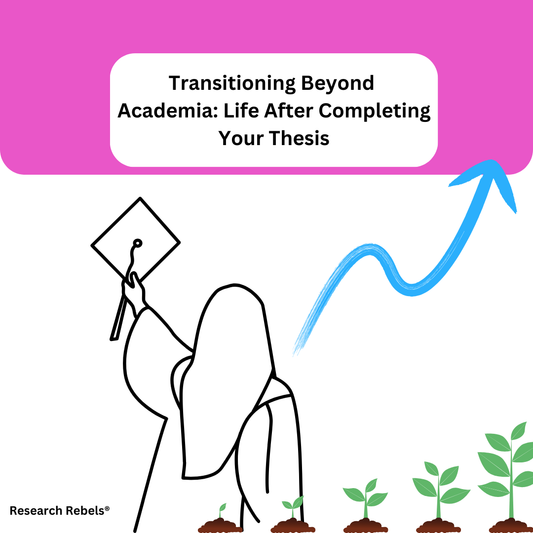
Transitioning Beyond Academia: Life After Completing Your Thesis

Trending Topics for Your Thesis: What's Hot in 2024

Thesis Action Plan

- Blog Articles
- Affiliate Program
- Terms and Conditions
- Payment and Shipping Terms
- Privacy Policy
- Return Policy
© 2024 Research Rebels, All rights reserved.
Your cart is currently empty.
Designing Capstone Experiences
Main navigation.

Starting with the graduating class of 2025, all Stanford undergraduates are required to complete a capstone project as part of their major (see capstone.stanford.edu ).
Capstones have been identified as a high-impact educational practice , providing opportunities for students to integrate and apply what they have learned during their major courses of study, strengthen relationships with instructors and mentors, and experience a range of personal and practical benefits.
CTL is excited to support departments and programs in the implementation of capstones. For all questions, email Kenneth Ligda at [email protected] , or file a CTL consultation request .
Exemplary capstone projects at Stanford
Capstones may take many forms, ranging from honors theses to community projects, seminars to group projects, e-Portfolios to research papers.
Many models for successful capstones already exist across Stanford departments and programs. Here, we provide a few exemplars to give a sense of both the possibilities and practicalities in this work.
Each of these capstone exemplars excel in two critical areas:
- providing opportunities for student-guided learning
- structuring experiences to help students meet challenging goals.
Through the capstone, students are often tasked with open-ended questions that push them to find novel or original answers. This offers students a unique opportunity to explore their own interests and direct their own learning. Whether students work on a team-based or individual project, they must use the knowledge and skills they have gained throughout their education to tackle complex problems that are often interdisciplinary in nature.
Preparing students for this kind of work can be challenging. A good place to start is with the learning goals from our capstone exemplars. The instructors identify important learning goals for their students that will help them transition into independent work and guide their own learning throughout the capstone.
But what happens when a student struggles with these ambitious learning goals? The capstone exemplars also discuss how their capstones have evolved over time to provide students with continuous support and feedback to help them throughout their capstone experience. The instructors describe how their capstones are structured to ensure students have clear guidelines at the start of their capstone and multiple checkpoints to meet the intended capstone learning goals.

Urban Studies

Bioengineering

Religious Studies

Human Biology
CTL offers the Capstone Experience Design (CapED) program to all departments and programs conferring undergraduate major degrees.
CapED is a two-day intensive to focus efforts on designing a successful capstone experiences. Modeled after CTL’s renowned Course Design Institute (CDI), CapED provides departments and programs a collaborative environment in which to design capstone experiences for their majors. Teams or individuals are welcome, and may include faculty, lecturers, staff, and undergraduate majors.
In CapED, we apply current research in teaching and learning to design effective and inclusive capstone projects suitable for diverse student majors. Learning goals for CapED participants include:
- Articulating student learning goals for the capstone project
- Drafting a capstone curriculum aligned with capstone learning goals and the major curriculum
- Integrating research-based practices into the capstone curriculum
- Evaluating capstone design to ensure equity and inclusion for all majors
- Receiving feedback from mentors in departments/programs with a capstone project
CapED Workshops and Materials
We are not currently planning another instance of CapED, but if you or your department/program are interested, please contact Kenny Ligda, [email protected] , for workshop materials or for a customized offering for your group.
- EN Action Another action
- Free Counselling
Thanks for visiting TopUniversities.com today! So that we can show you the most relevant information, please select the option that most closely relates to you.
- Looking for undergraduate studies
- Looking for postgraduate studies
- Student but not looking for further education at the moment
- Parent or Guardian
- University administrator
- Professional
Thanks for sending your response.
Your input will help us improve your experience. You can close this popup to continue using the website or choose an option below to register in or login.
Already have an account? Sign in
What is a capstone project? And why is it important?

Stephanie Lukins
Share this Page
Table of contents
- Introduction

It prepares you for the working world
It helps build your cv and help you stand out as a candidate , it offers valuable practical experience – something many graduates do not have, it hones on specific skills that are highly valued by employers.
Sponsored by York University
What is a capstone project?
The capstone project has become an integral part of the university degree curriculum. It can take many various forms, but its purpose remains the same. The capstone project is a unique opportunity to carry out independent group research in order to devise an innovative solution for a real-world problem. While a project of this scope and scale can be challenging, it can also be very rewarding.
The capstone project is usually the final assignment and plays a vital role in preparing students for the world of work thanks to its practical applications and ability to help hone students’ professional knowledge and skills.
At York University in Toronto, Canada, things are a little different. In 2019, the university revised the traditional capstone project and created C4: Cross-Campus Capstone Classroom . While it still possesses the fundamentals of the traditional capstone project, C4 is a new, year-long initiative that brings students together from various degree programmes to work in interdisciplinary teams with faculty and project partners on real-world challenges pitched by non-profit organisations, start-ups and businesses to create social impact.
TopUniversities spoke to Megan Tran and Javeria Mirza, two students at York University, to find out about their capstone project and why they feel it has played an important role in not just their academic development, but their professional development as well.
What is the purpose of a capstone project?
The capstone project is designed to consolidate final-year students’ learning with valuable hands-on experience to help develop them into well-prepared and well-rounded graduates.
Students work together in small groups to come up with innovative solutions for real-life problems, all while gaining valuable insights into the demands and responsibilities of the working world. This gives students a chance to bring their leadership and management skills alive and understand the consequences of their decisions in a ‘safe space’.
C4 gives students an insight into global affairs, international relations as well as social corporate responsibility and sustainability.
Final-year bachelor’s in international studies student Megan and master’s in political science student Javeria were two of the eight interdisciplinary students, from the Faculty of Environmental Studies, the Lassonde School of Engineering, Glendon College, and the Faculty of Liberal Arts & Professional Studies at York University who worked together on the ‘Solar Floatie’ project.
“As a group, we were all interested in using technology and design-thinking for good. Our collective passion for social impact brought us together as a team. CooperLab at York University led by Professor Thomas Cooper was already spearheading the idea of an inflatable solar collector,” said Javeria.
“But how we went about developing the technology and what we wanted to use it for was up to us,” added Megan.
“ The Solar Floatie was born when the engineering side of the solar collector project was merged with the anthropology side and the United Nations Sustainable Development Goals (SDG) framework to propose a sustainable implementation model,” explained Javeria.
Undertaking a capstone project demonstrates to prospective employers that you’re more than just a potential candidate with the necessary academic qualifications. It shows your dedication to an issue which demands time and effort, as well as strict professionalism, work ethic and experience working in a practical, hands-on setting.
As a graduate, the reality of securing a job can be difficult as many roles demand practical experience. Many graduates are conceptually strong and suitable candidates, but a lack of applied knowledge in practical settings can make it challenging to demonstrate such experience and skills on their CV or in an interview.
The capstone project is a great solution and is something which both Megan and Javeria felt helped bridge that critical gap and has given them a competitive advantage as young professionals.
“It gave me an opportunity to learn outside a traditional academic setting and allowed me to explore my interest in sustainability and passion for social impact,” said Megan. “Since being a part of this project, I’ve been involved with a variety of organisations carrying out work that align with these passions.”
Javeria echoes Megan’s sentiments.
She said: “Bridging the lessons learnt during the capstone project such as the value of continuously learning, taking initiative, and working effectively with people from diverse disciplinary backgrounds has been invaluable in both my UN work and my graduate studies.”
Testimonials

"I’d been working as a data analyst back in India. I knew what my career prospects were and it was just a case of deciding which university would be better suited. Obviously, that's where the QS rankings proved useful."
Read my story
Saurabh Kulkarni Durham University Business School student

"I chose to remain in India for my gap year to take on several different opportunities and roles and gain more real-life experience. I found out what it’s like to work in an office, and also learned a lot about myself during that time."
Jugnu Nagar JECRC University student

"QS were a huge help from the very beginning. When I felt overwhelmed about the options available, it was my counsellor who helped me to clarify my goals and find a programme that would be best suited for my future."
Bibil Jose Arizona State University student

"I’m grateful to have selected a co-op programme for my degree. It helped me gain significant industry skills and amazing memories that I will take into my career. My resume already looks full of experience before I’ve even graduated."
Pratibha Muthukumarasamy University of Waterloo student
The capstone project encompasses a real-life working culture which aims to instil a set of specific skills that are both highly valued by employers and will ultimately serve students well into their careers.
York University’s C4 focuses on the development of a wide range of skills, including creative, critical, and strategic thinking, effective communication, teamwork, problem solving and research analysis through diverse learning approaches and perspectives. Students deepen their sense of social and ethical responsibilities as they learn to mobilise their knowledge across disciplines and work effectively in interdisciplinary teams while engaging professionally with their peers and professors.
Lead image: Solar Floatie project team members work on assembling the solar energy collector, under Professor Thomas Cooper’s direction. Credit: York University
+ 2 others saved this article
+ 3 others saved this article
As the former Head of Sponsored Content for TopUniversities.com and TopMBA.com, Stephanie created and published a wide range of articles for universities and business schools across the world. She attended the University of Portsmouth where she earned a BA in English Language and an MA in Communication and Applied Linguistics.
Recommended articles Last year

Top universities for physics
Top mechanical engineering schools

Top universities for veterinary science
Discover top-ranked universities.
universities
events every year
Sign up to continue reading
Ask me about universities, programs, or rankings!

Our chatbot is here to guide you.
QS SearchBot
Research Design Canvas
- First Online: 10 June 2024
Cite this chapter

- Rashina Hoda ORCID: orcid.org/0000-0001-5147-8096 2
This chapter focuses on describing how to go about designing a research project. First, we will learn about framing the research study as a project . Then, we will be introduced to the research design canvas . While the details are specific to socio-technical grounded theory (STGT) studies, the research design canvas or template can be used for research project design in general. Next, we will learn about the 10 elements of the research design canvas, including the forming of the research team , identifying the domain and actors , selecting the phenomenon and topic to investigate, carefully assessing research ethics and considering the research values , formulating the guiding research questions , acknowledging the team’s research philosophy , deciding on the initial research protocols including data, techniques, and tools, and listing the desirable research impact . The chapter concludes by describing a pilot study to apply and refine the above elements of the research project design.
This is a preview of subscription content, log in via an institution to check access.
Access this chapter
Subscribe and save.
- Get 10 units per month
- Download Article/Chapter or eBook
- 1 Unit = 1 Article or 1 Chapter
- Cancel anytime
- Available as PDF
- Read on any device
- Instant download
- Own it forever
- Durable hardcover edition
- Free shipping worldwide - see info
Tax calculation will be finalised at checkout
Purchases are for personal use only
Institutional subscriptions
Unable to display preview. Download preview PDF.
Creswell, J. W., & Poth, C. N. (2016). Qualitative inquiry and research design: Choosing among five approaches . Sage publications.
Google Scholar
Dittrich, D., Kenneally, E., et al. (2012). The menlo report: Ethical principles guiding information and communication technology research. Technical report , US Department of Homeland Security.
El-Emam, K. (2001). Ethics and open source. Empirical Software Engineering, 6 (4), 291.
Article Google Scholar
El-Migid, M.-A. A., Cai, D., Niven, T., Vo, J., Madampe, K., Grundy, J., & Hoda, R. (2022). Emotimonitor: A trello power-up to capture and monitor emotions of agile teams. Journal of Systems and Software, 186 , 111206. https://www.sciencedirect.com/science/article/pii/S016412122100279X
Garousi, V., Felderer, M., & Mäntylä, M. V. (2019). Guidelines for including grey literature and conducting multivocal literature reviews in software engineering. Information and Software Technology, 106 , 101–121.
Gold, N. E., & Krinke, J. (2020). Ethical mining: A case study on MSR mining challenges. In Proceedings of the 17th International Conference on Mining Software Repositories (pp. 265–276).
Hassan, A. E. (2008). The road ahead for mining software repositories. 2008 Frontiers of Software Maintenance (pp. 48–57). IEEE.
Hoda, R. (2022). Socio-technical grounded theory for software engineering. IEEE Transactions on Software Engineering, 48 (10), 3808–3832.
Hoda, R., & Noble, J. (2017). Becoming agile: a grounded theory of agile transitions in practice. In 2017 IEEE/ACM 39th International Conference on Software Engineering (ICSE) (pp. 141–151). IEEE.
Hussain, W., Perera, H., Whittle, J., Nurwidyantoro, A., Hoda, R., Shams, R. A., & Oliver, G. (2020). Human values in software engineering: Contrasting case studies of practice. IEEE Transactions on Software Engineering, 48 (5), 1818–1833.
Hussain, W., Shahin, M., Hoda, R., Whittle, J., Perera, H., Nurwidyantoro, A., Shams, R. A., & Oliver, G. (2022). How can human values be addressed in agile methods? a case study on safe. IEEE Transactions on Software Engineering, 48 (12), 5158–5175.
Institute, P. M. (2008). A guide to the project management body of knowledge (PMBOK ® guide).
Madampe, K., Hoda, R., & Grundy, J. (2021). A faceted taxonomy of requirements changes in agile contexts. IEEE Transactions on Software Engineering, 48(10), 3737–3752.
Madampe, K., Hoda, R., & Singh, P. (2020). Towards understanding emotional response to requirements changes in agile teams. In Proceedings of the ACM/IEEE 42nd International Conference on Software Engineering: New Ideas and Emerging Results (pp. 37–40).
Osterwalder, A., & Pigneur, Y. (2010). Business model generation: A handbook for visionaries, game changers, and challengers (Vol. 1). Wiley.
Pant, A., Hoda, R., Tantithamthavorn, C., & Turhan, B. (2024). Ethics in AI through the developer’s view: A grounded theory literature review and guidelines. Empirical Software Engineering, 29 (3), 67.
Perera, H., Hussain, W., Whittle, J., Nurwidyantoro, A., Mougouei, D., Shams, R. A., & Oliver, G. (2020). A study on the prevalence of human values in software engineering publications, 2015-2018. In 2020 IEEE/ACM 42nd International Conference on Software Engineering (ICSE) (pp. 409–420). IEEE.
Perry, D. E., Porter, A. A., & Votta, L. G. (2000). Empirical studies of software engineering: A roadmap. In Proceedings of the Conference on The Future of Software Engineering (pp. 345–355).
Salleh, N., Hoda, R., Su, M. T., Kanij, T., & Grundy, J. (2018). Recruitment, engagement and feedback in empirical software engineering studies in industrial contexts. Information and Software Technology, 98 , 161–172.
Saunders, M., & Tosey, P. (2013). The layers of research design. Rapport (Winter), 58–59.
Schwartz, S. H. (1992). Universals in the content and structure of values: Theoretical advances and empirical tests in 20 countries. In Advances in experimental social psychology (Vol. 25, pp. 1–65). Elsevier.
Singer, J., & Vinson, N. G. (2001). Why and how research ethics matters to you, yes you!. Empirical Software Engineering, 6 (4), 287–290.
Singer, J., & Vinson, N. G. (2002). Ethical issues in empirical studies of software engineering. IEEE Transactions on Software Engineering, 28 (12), 1171–1180.
Townsend, L., & Wallace, C. (2016). Social media research: A guide to ethics. University of Aberdeen, 1 (16), 1–16. https://www.gla.ac.uk/media/Media_487729_smxx.pdf
Wohlin, C., & Aurum, A. (2015). Towards a decision-making structure for selecting a research design in empirical software engineering. Empirical Software Engineering, 20 , 1427–1455.
Wolfswinkel, J. F., Furtmueller, E., & Wilderom, C. P. (2013). Using grounded theory as a method for rigorously reviewing literature. European Journal of Information Systems, 22 (1), 45–55.
Download references
Author information
Authors and affiliations.
Faculty of Information Technology, Monash University, Melbourne, VIC, Australia
Rashina Hoda
You can also search for this author in PubMed Google Scholar
Rights and permissions
Reprints and permissions
Copyright information
© 2024 The Author(s), under exclusive license to Springer Nature Switzerland AG
About this chapter
Hoda, R. (2024). Research Design Canvas. In: Qualitative Research with Socio-Technical Grounded Theory. Springer, Cham. https://doi.org/10.1007/978-3-031-60533-8_4
Download citation
DOI : https://doi.org/10.1007/978-3-031-60533-8_4
Published : 10 June 2024
Publisher Name : Springer, Cham
Print ISBN : 978-3-031-60532-1
Online ISBN : 978-3-031-60533-8
eBook Packages : Computer Science Computer Science (R0)
Share this chapter
Anyone you share the following link with will be able to read this content:
Sorry, a shareable link is not currently available for this article.
Provided by the Springer Nature SharedIt content-sharing initiative
- Publish with us
Policies and ethics
- Find a journal
- Track your research
- Our features
- How we work
Capstone Design Projects Writing Service
The capstone design project is always part of any engineering curriculum because it is here where the lessons you’ve learned throughout the years will be put to the test as you create a service or device that can contribute to the society. This means your capstone research project should be well thought of and that it should meet the requirements asked of you by your mentor or professor. This can be challenging especially when you need to do more than just researching and writing your paper. You will also need to create an output that you can display once you submit your capstone design project.
What Should Be Included in Capstone Design Project Ideas?
Capstone design projects need to be completed to a high standard and on time if you are to graduate the course you are following. This will very much depend on the topic that you choose for your research. Make a mistake at the start and you could make a huge amount of work for yourself or even fail to complete your paper to the standards expected. This is why your capstone interior design project ideas must be selected with care.

Knowing precisely what is expected of them will help you with making your decisions:
- You must select an idea that allows you to demonstrate what you have learned: the topic must be relevant to your course and of a difficulty level that will allow you to use what you have learned to solve it.
- The idea must be important and unique: you need to find a real-world problem that you will be able to solve that will add value within the area of design. Do not select something that already has a solution unless you are confident that you can find a better answer.
- It must be able to hold your attention: with many projects lasting a year it is very important that you select an idea that will keep your interest. It is hard to work on something if you have no interest in it.
- It must be something you can actually finish: you have only the resources that are to hand the time you have been given. If you cannot finish the project with those resources then you are likely to fail.
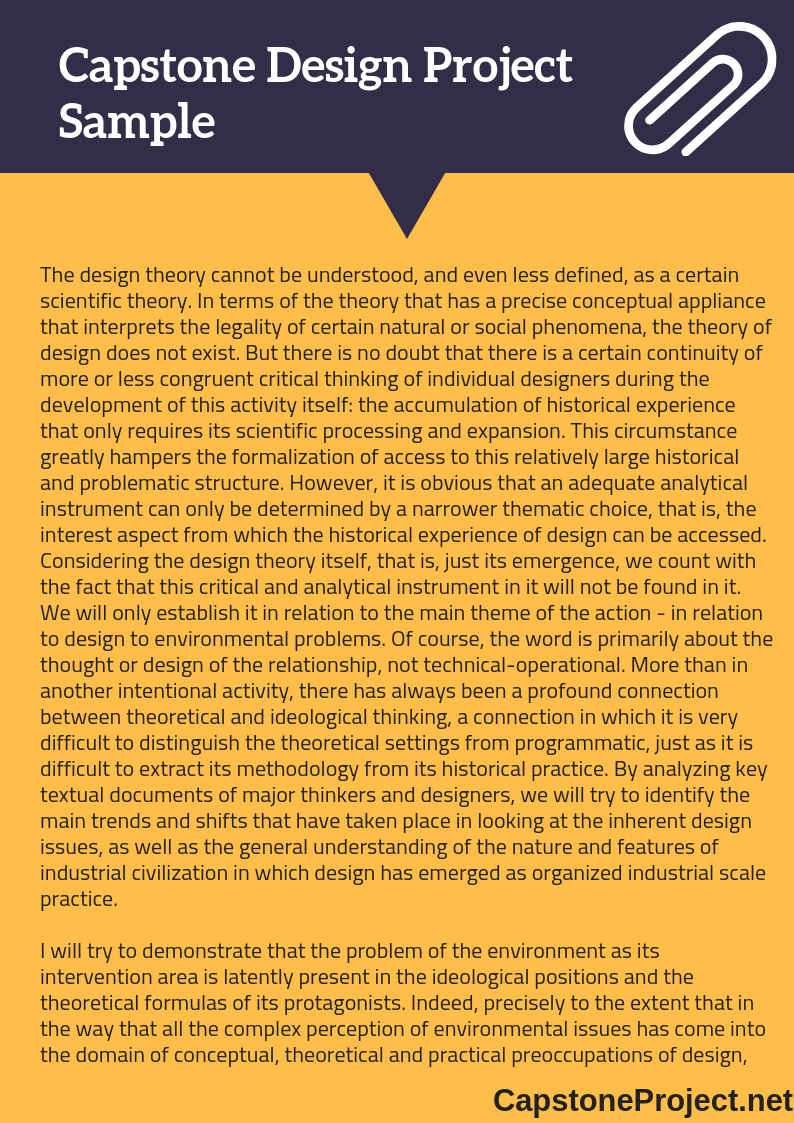
How to Write Excellent Capstone Design Projects
Even with the best capstone design project ideas and a good senior capstone projects you are going to have a huge amount of work to do with writing your research up. The paper must be perfectly written without any mistakes. While it may seem you have a lot of time available to get the work done it is surprising just how quickly that time can pass. The following tips will help you to keep your writing on track and to create a paper you will be proud of:
- Plan your work: as with your research, it is best to create a plan for the writing you need to complete and follow it. Capstone design projects may require extra time for conceptual development. Plus, plan time for work review and set milestones for when you expect each section of your paper to be completed.
- Make an outline: knowing what you will write will aid you in getting your words down quickly without excessive amounts of rewriting. A good outline will also help to highlight any problems that you may have with your writing at an earlier stage in the process.
- Have a routine to drive progress: doing your work at the same time each day and having an achievable target for the number of words you are going to write will ensure that you make clear and steady progress towards completing your paper.
- Edit and proofread: submitting work that may be ambiguous, be unclear, or contain errors is asking for your paper to be rejected. Always ensure that you review your writing with care and ask others for their opinions also.
Importance of Capstone Design Conference
If you want to find out more on how important your capstone design project is, why not attend a capstone design conference in your area? This conference provides engineering students and professionals with ideas on what the future holds for engineers around the world. Here you will find slideshows on recently developed designs depending on what capstone design course was taken by the student. What’s more, you can engage others to discuss ideas that you can use for your capstone design writing.
30 Topics for Capstone Interior Design
The following are 30 capstone design project ideas that you could use or read to inspire more ideas of your own:
- Designing collapsible emergency housing
- Creating an effective solar oven
- Effective filter for home waste water
- Low cost desalination
- Harvesting atmospheric water at no cost
- Low power low cost internet access
- Portable water drinking water filtration system
- Generation of power from a small stream
- Ergonomic seating design for the office
- Car gas strut replacement
- Mechanical golfer for a hole in one
- Water sanitization system using UV
- Mechanical grip design for robot handling
- Improved impact resistance for mobile phone cover
- Socks for improved frostbite defense
- Green wall building
- Inspection robot design for pipeline
- System to unload motorcycle from a truck
- Design of underwater camera drone
- Manual landmine removal methods
- Awareness of sustainable principles and social responsibilities
- Facilitate design study abroad programs
- Interior design education for diverse backgrounds
- Creative interior design expressions
- Global aspects on modern designs
- Ethnic designs and it relationship to culture
- Practical and sedate artistic design applications
- Effect of design in various topologies
- Highlights of interior decoration in small spaces
- Upcoming and new design trends
Want more? Explore these architecture project ideas from our experts!
Who Can Help with Your Capstone Interior Design Project?
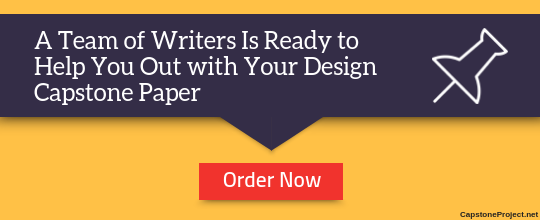
How We Can Help with Your Capstone Design Project
We have the best team of writers available that can help you with your capstone design project right from the start. All that you have to do is to provide us with the information we will need to write your paper and we can provide you with drafts until we complete the project.
We offer our support through fully qualified and highly experienced staff that will work directly with you to achieve the best possible results with your writing. They only offer support that will result in unique to ensure it is original and free from any issues.
Make your capstone design projects shine with the support of our affordable and reliable writing and editing services!

You have an opportunity to get your capstone project done week by week by the same writer according to the timeline.
We write your capstone project from the ground up and double-check it with plagiarism detection software.
We assign no general writers to your order. You are guaranteed to work with one of the top-rated PhD/MA experts in your area.
Capstone Design
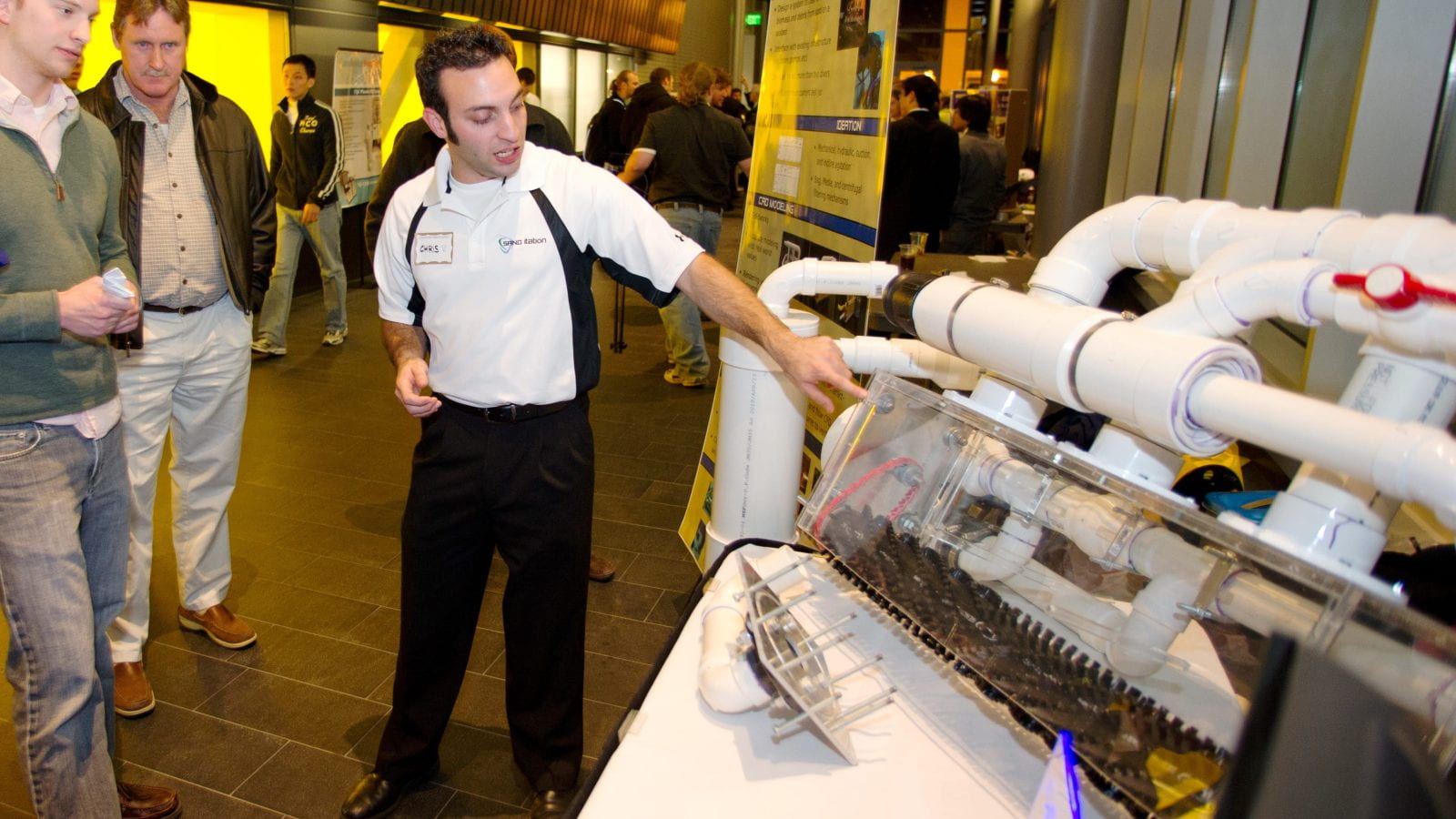
Capstone Design is a culminating course offered to undergraduate students in several disciplines at the Georgia Institute of Technology. Students work in teams to design, build, and test prototypes with real world applications. At the end of each semester students showcase their efforts at the “Capstone Design Expo”.
The Capstone Design course provides students the opportunity to work with real-world, open-ended, interdisciplinary challenges proposed by industrial and research project sponsors. They learn and apply the engineering design process: defining functional requirements, conceptualization, analysis, identifying risks and countermeasures, selection, and physical prototyping.
Student teams design and build working, physical prototypes to validate their solutions. By working in teams they develop leadership skills and group dynamics; dealing with scheduling conflicts, meeting weekly deliverables and deadlines; and communication among team members, project sponsors, and course instructors.
Teams attend lectures given by experts from Industry and Academia on topics including industrial design, manufacturing, market research and marketing, intellectual property, company formation, codes and standards, and ethics.
At the end of the semester, student teams display and pitch their inventions and marketability to a panel of judges, invited guest, media, and their peers, while competing for cash prizes. This is an excellent opportunity for sponsors to see how their project was conceptualized by the teams at the expo.
UX design in agile: A DSDM case study
- Lecture Notes in Business Information Processing 179
- Conference: 15th International Conference, XP 2014
- At: Rome, Italy
- Volume: 179
- This person is not on ResearchGate, or hasn't claimed this research yet.

- The Open University (UK)

- University of Glasgow

- University of Central Lancashire
Abstract and Figures
![research design in capstone project 'Train tracks' development where UX designers work one timebox ahead of agile developers [15].](https://www.researchgate.net/profile/Peggy-Gregory/publication/265849113/figure/fig1/AS:479031536689152@1491221426187/Train-tracks-development-where-UX-designers-work-one-timebox-ahead-of-agile-developers_Q320.jpg)
Discover the world's research
- 25+ million members
- 160+ million publication pages
- 2.3+ billion citations

- Mateusz Kwiatkowski

- Kun-Pyo Lee

- INT J HUM-COMPUT ST

- Khuram Nawaz Khayam
- Wajahat Ali Khan
- Ben Anderson
- Lucy Nohemy
- Medina Velandia
- Wílmer Mesías
- wilmer mesias lopez
- Ayesha Khalid

- Laura Plonka

- Hugh Robinson
- Minna Isomursu
- Andrey Sirotkin
- Petri Voltti
- Markku Halonen

- Agile Manifesto
- J. J. Garrett
- Jukka Haikara
- Michael Budwig
- Soojin Jeong
- Kuldeep Kelkar
- Recruit researchers
- Join for free
- Login Email Tip: Most researchers use their institutional email address as their ResearchGate login Password Forgot password? Keep me logged in Log in or Continue with Google Welcome back! Please log in. Email · Hint Tip: Most researchers use their institutional email address as their ResearchGate login Password Forgot password? Keep me logged in Log in or Continue with Google No account? Sign up

Virtual Tour
Experience University of Idaho with a virtual tour. Explore now
- Discover a Career
- Find a Major
- Experience U of I Life
More Resources
- Admitted Students
- International Students
Take Action
- Find Financial Aid
- View Deadlines
- Find Your Rep

Helping to ensure U of I is a safe and engaging place for students to learn and be successful. Read about Title IX.
Get Involved
- Clubs & Volunteer Opportunities
- Recreation and Wellbeing
- Student Government
- Student Sustainability Cooperative
- Academic Assistance
- Safety & Security
- Career Services
- Health & Wellness Services
- Register for Classes
- Dates & Deadlines
- Financial Aid
- Sustainable Solutions
- U of I Library

- Upcoming Events
Review the events calendar.
Stay Connected
- Vandal Family Newsletter
- Here We Have Idaho Magazine
- Living on Campus
- Campus Safety
- About Moscow

The largest Vandal Family reunion of the year. Check dates.
Benefits and Services
- Vandal Voyagers Program
- Vandal License Plate
- Submit Class Notes
- Make a Gift
- View Events
- Alumni Chapters
- University Magazine
- Alumni Newsletter

SlateConnect
U of I's web-based retention and advising tool provides an efficient way to guide and support students on their road to graduation. Login to SlateConnect.
Common Tools
- Administrative Procedures Manual (APM)
- Class Schedule
- OIT Tech Support
- Academic Dates & Deadlines
- U of I Retirees Association
- Faculty Senate
- Staff Council
Engineering Design EXPO
U of I College of Engineering
Janssen Engineering (JEB) Room 125 875 Perimeter Drive MS 1011 Moscow, ID 83844-1011
Phone: 208-885-6470
Fax: 208-885-6645
Email: [email protected]
Web: College of Engineering
U of I Boise Engineering
Idaho Water Center 322 E. Front Street Boise, ID 83702
Phone: 208-364-6123
Fax: 208-364-3160
Email: [email protected]
Web: Boise Engineering
Idaho Falls
U of I Idaho Falls Engineering
1776 Science Center Drive, Suite 306 Idaho Falls, Idaho 83402
Phone: 208-757-5400
Fax: 208-282-7929
Email: [email protected]
Web: Idaho Falls Engineering
Coeur d'Alene
U of I CDA Computer Science
Physical Address: 1000 W Garden Ave, Hedlund Building Room 202, Coeur d'Alene, ID 83814
Phone: 208-292-2509
Email: [email protected]
Web: U of I Coeur d'Alene
Student Services
Distance education.
Engineering Outreach
Engineering Physics (EP) Building, Room 312 875 Perimeter Drive MS 1014 Moscow, ID 83844-1014
Phone: 208-885-6373
Fax: 208-885-9249
Email: [email protected]
Web: Engineering Outreach
EXPO Student Projects
Recognized by the National Academy of Engineering as one of top seven in the nation, the University of Idaho College of Engineering Capstone Program infuses real-world experiences into undergraduate engineering education.
Engineering students work in interdisciplinary teams on creative projects that emphasize the design process and the creation of a thoughtfully engineered, tested and validated outcome or prototype.
Explore 2024 Student Projects
Save the date: april 29-30.
Refer back to this website for project details.
Past Student EXPO Projects
2023 student projects, project index.
Biological Engineering
- Stem Cell Tendon Bioreactor
- Evaluation of Biofilm Resistant Coatings for Spacecraft Water Systems
- 3D Printed Flexible Spine Model for Drug Delivery to the Brain
- Measuring Nerve Response in Earthworms from Minimal Electrical Stimulus
Civil & Environmental Engineering
- New Office Building for General Contractor -- Kapolei, Hawaii
- Nezperce Sewer Reuse System
- SH-3 Potlatch River Bridge Replacement
- Oreana Dam Replacement
- Kootenai County Integrated Clinic
- Lacrosse Ave intersection and Expansion
- Solids Management Improvement Project – Anaerobic Digester Seeding with Hydrolyzed Sludge
- USACE Fish Ladder Temperature Control Design
- Post Falls Apartments
Chemical Engineering
- Plastic Waste to Fuel: Recycling in Bali
- Pyrolysis Oil Purification Design: Closing the Plastic Economy
- Optimization of the Mixstix Platform
- Pressure Swing Adsorption: Separation of Nitrogen and Oxygen from Air
Computer Science
- Automated Visio Construction
- Autocalibration Software for Optical Receiver Arm Alignment
- Automated Installation of Keys
- Gamified Virtual Worlds and Computer Simulation
- Big Data Analysis for Elliptical Pattern Identification
Electrical & Computer Engineering
- Secure Helios Processor Demonstration
- Infrasonic Wildfire Detection and Reporting Devices
- Detecting and Locating Cancelling Faults in Shunt Capacitor Banks
- Mars Javelin
- AI/ML based Natural Language Interfaces to Databases
Mechanical Engineering
- Leg Exoskeleton for Multiple Sclerosis
- Cryogenic Tensile Tester
- Prandtl-D Flying Wing Demonstration
- Aircraft Fuel Crash Shutoff Safety Valve
- Pendant Controller for Automated Fork Truck
- Demonstration of Small-Scale Continuous Casting
- Robotic Assembly of Photovoltaic Arrays
- Reciprocating Saw End-Effector for Hot-Cell Robotic Arm
- Universal Circuit Board Pallet
- MLM Armrest Adjustment Locking Mechanism
- Oil Film Interferometry
- Impulse Measurement Device: Measuring forces created by rimfire ammunition
2022 Student Projects
- Portable Biodiesel Production System
- Shear Stress Bioreactor to Study Mechanobiology of Stem Cells
- Continuous Biochar Reactor to Improve Crop Nutrient and Water Retention
- US-95 Over Four Mile Creek
- Rapid Lightning Creek Bridge #5
- Lewiston Well #7
- Camp Sweyolakan Water Facility Plan and Upgrade
- SR-248 Shoulder Running Bus
- Floating Feather Road & Bridge Renovation
- Crestview Dr. Roundabout
- Fourth Street and Honeysuckle Avenue Roundabout
- Modular Distributed Gas-to-Liquids (GTL) Synthesis
- Pressure Swing Adsorption: A Functional Apparatus and Future Teaching Tool
- Acid Mine Drainage Prevention at Bunker Hill Mine
- Conversion of CO2 into Value-added Product
- Sentence Expansion for Online Storytelling
- Human Machine Interface Gesture System
- Electric Blocks II - Realistic Power Sim. in Minecraft
- VMCraft II - Minecraft Virtualization
- Video Game Environment for Arm Assessment through a Robotic Exoskeleton
- OnlyFactories - Factory 4.0
- Infrasonic Wildfire Detection
- Bayview Navy - Auxiliary Power System for Submarine Guidance Navigation Controller
- Tangible Object Recognition: Joystick
- Attitude Determination and Control System for Small Satellite Bus
- Design of Energy Management System Simulation Exercises
- Debaling Agricultural Materials for Bioprocessing Industries, Implementing an Anti-clogging Algorithm
- Fixture for Measuring Backlash in Rifle Scopes
- Nuclear Fuel Pin Jacket Production
- Non-Destructive Inspection of Electronics Using CT
- Pop 'n Lock Robotic Arm
- Leg Exoskeleton for Multiple Sclerosis Walking Assistance
- Single Lever Tilt and Telescope Adjustment
- Package Dropping Machine
- Two Stroke Engine Emissions and Calibration
- Fire-Resistant Wind Tunnel
- Tracked Forestry Research Robot
- Modernization of Military Electric Vehicle Conversion

IMAGES
VIDEO
COMMENTS
The Research Design explains what type of research is being conducted in the needs assessment. The writing in this heading also explains why this type of research is needed to obtain the answers to the research or guiding questions for the project. The design provides a blueprint for the methodology.
Understand the multifaceted nature and purpose of a capstone project within an academic curriculum and its real-world applications. Choose a topic that aligns with your interests, is feasible to research, and supports your career goals. Conduct a thorough literature review to gather relevant sources, analyze existing research, and identify gaps ...
In capstone project research, theory and practice come together in new and . ... Chapter 4 will delve deeper into the rst step of the capstone project design, which is the .
This document provides guidance for students completing a capstone research design project at the Naval Academy. It outlines the course requirements over two semesters, including project proposals, preliminary design reports, detail design reports, and a final status memo. It also provides information on the course shared drive, design documentation formatting and submission, purchase orders ...
have been made, you must complete a Capstone Project Proposal Form which includes a 2-3 paragraph tentative thesis topic and research design, and the signature of your advisor and Second Reader. Your advisor's signature indicates approval of the Project. Once you have completed the form, you will be given the CRN for registering for the Capstone.
Choosing a Design for Your Capstone Project. y for Your Capstone ProjectSecondary Data AnalysisSecondary data analysis can be a way for the nurse researcher who lacks access to additional resources or assist. ve personnel to make a significant analytic impact. Secondary data are essentially data collected by another individual for a.
As a research institution, this investment is most often in man-hours spent. developing the initial research proposal. In 2018, the United States government spent $142.9 billion funding research and. development activities.1 This funding makes up only a portion of the overall research.
In CapED, we apply current research in teaching and learning to design effective and inclusive capstone projects suitable for diverse student majors. Learning goals for CapED participants include: Articulating student learning goals for the capstone project; Drafting a capstone curriculum aligned with capstone learning goals and the major ...
A research hypothesis is the statement created by a researcher when they speculate upon the outcome of their research-based capstone project. Research-based capstone projects based on program design, development, and implementation that focus on an identified problem or need should also have a hypothesis.
(1) A source used in research and mentioned by a researcher in a paper or an article. (2) In libraries, a part of the library's collection that includes encyclopedias, handbooks, directories, and other publications that provide useful overviews, common practices, and facts.
Ability to design and complete a research report The applied research report (ARR) may also be referred to as the capstone project or educational report. 1.3 SOE Doctoral Community
The capstone project is a unique opportunity to carry out independent group research in order to devise an innovative solution for a real-world problem. While a project of this scope and scale can be challenging, it can also be very rewarding. The capstone project is usually the final assignment and plays a vital role in preparing students for ...
Microsoft Word - McLaughlin_Dept Format_1kc_3 (002).docx. This capstone paper is posted as an example of the type of work and writing that meets the capstone individual research project final paper requirement for the NRES non-thesis M.S. option. This should not be used as a guide for formatting.
Project Proposal (Research Design in Sustainability 2) Michael Kung, Ed.D. ARCH 130. Conference Room Open (ARC130) or by [email protected] Topics in Sustainability is the second of two courses that help students in the Masters in Sustainable Design Degree Program develop the foundations.
an academic-focused research project with broader applicability. Both projects should clearly state a problem or issue to be addressed. Both projects involve a review of the existing literature, collection of data or conduction of a project, analysis of results, and statement of conclusion. The primary difference lies in the scope and the focus ...
capstone projects is presented in the next section. 2. Capstone Design Project - Theory Meets Practice 2.1 Low-cost adjustable goose-neck automotive hitch assembly [6] 2.1.1 Background and need The gooseneck ball trailer hitch design has been around for more than 50 years with virtually no updates during that time.
This chapter focuses on describing how to go about designing a research project. First, we will learn about framing the research study as a project.Then, we will be introduced to the research design canvas.While the details are specific to socio-technical grounded theory (STGT) studies, the research design canvas or template can be used for research project design in general.
30 Topics for Capstone Interior Design. The following are 30 capstone design project ideas that you could use or read to inspire more ideas of your own: Designing collapsible emergency housing. Creating an effective solar oven. Effective filter for home waste water.
This paper, however, focuses on quality measurement, specifically the development of two distinct instruments designed to measure the quality of a design outcome, the Client Satisfaction Questionnaire (CSQ) and the Design Quality Rubric (DQR). After a review of the common assessment strategies currently in use for senior capstone courses, the ...
The Capstone Design course provides students the opportunity to work with real-world, open-ended, interdisciplinary challenges proposed by industrial and research project sponsors. They learn and apply the engineering design process: defining functional requirements, conceptualization, analysis, identifying risks and countermeasures, selection ...
involves producing Wireframes, visual designs, interface widgets, user. characterisations, and performing user research and usabilit y testing. In this paper we present a case study that explores ...
Email. [email protected]. Mailing Address. Virtual Technology & Design. University of Idaho. 875 Perimeter Drive MS 2481. Moscow, Idaho 83844-2481. My journey began in the field of architecture designing and building user experiences in commercial, educational, housing and resort development. As digital tools emerged in the 1980s, I incorporated ...
EXPO is the longest-running student engineering and technological innovation showcase in the Pacific Northwest. The event welcomes K-12 and community college students, industry partners and community members to explore industry-sponsored projects designed by current U of I students in the college's Interdisciplinary Capstone Design Program, ranked top seven in the nation for infusing real ...
EXPO Student Projects. Recognized by the National Academy of Engineering as one of top seven in the nation, the University of Idaho College of Engineering Capstone Program infuses real-world experiences into undergraduate engineering education. Engineering students work in interdisciplinary teams on creative projects that emphasize the design ...